

Masterpieces of Western Art. Index of /bsuva. Council of Trent. The Council in Santa Maria Maggiore church; Museo Diocesano Tridentino, Trento.

The Council of Trent (Latin: Concilium Tridentinum) was an ecumenical council of the Catholic Church. It is considered to be one of the Church's most important councils.[1] It convened in Trento, Italy, then the capital of the Prince-Bishopric of Trent of the Holy Roman Empire, between 13 December 1545, and 4 December 1563 in twenty-five sessions for three periods.
Art Nouveau. Art Nouveau is considered a "total" art style, embracing architecture, graphic art, interior design, and most of the decorative arts including jewellery, furniture, textiles, household silver and other utensils and lighting, as well as the fine arts.
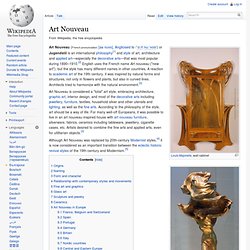
According to the philosophy of the style, art should be a way of life. For many well-off Europeans, it was possible to live in an art nouveau-inspired house with art nouveau furniture, silverware, fabrics, ceramics including tableware, jewellery, cigarette cases, etc. Artists desired to combine the fine arts and applied arts, even for utilitarian objects.[3] Untitled. Arts and Crafts Movement. The Arts and Crafts movement was an international design movement that flourished between 1860 and 1910, especially in the second half of that period,[1] continuing its influence until the 1930s.[2] It was led by the artist and writer William Morris (1834–1896) during the 1860s,[1] and was inspired by the writings of John Ruskin (1819–1900) and Augustus Pugin (1812–1852), although the term "Arts and Crafts" was not coined until 1887, when it was first used by T.
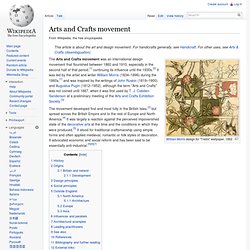
J. Cobden-Sanderson at a preliminary meeting of the Arts and Crafts Exhibition Society.[3] The movement developed first and most fully in the British Isles,[2] but spread across the British Empire and to the rest of Europe and North America.[4] It was largely a reaction against the perceived impoverished state of the decorative arts at the time and the conditions in which they were produced.[5] It stood for traditional craftsmanship using simple forms and often applied medieval, romantic or folk styles of decoration. William Morris. William Morris self-portrait, 1856 William Morris (24 March 1834 – 3 October 1896) was an English artist, writer, textile designer and socialist associated with the Pre-Raphaelite Brotherhood and English Arts and Crafts Movement.[1][2] He founded a design firm in partnership with the artist Edward Burne-Jones, and the poet and artist Dante Gabriel Rossetti which profoundly influenced the decoration of churches and houses into the early 20th century.
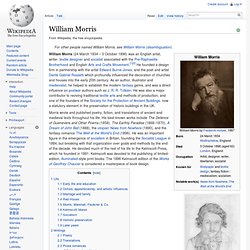
As an author, illustrator and medievalist, he helped to establish the modern fantasy genre, and was a direct influence on postwar authors such as J. R. R. Roman Empire. History of painting. The history of painting reaches back in time to artifacts from pre-historic humans, and spans all cultures.
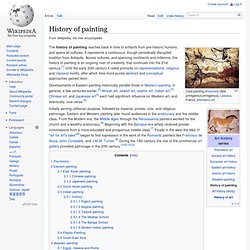
It represents a continuous, though periodically disrupted tradition from Antiquity. Across cultures, and spanning continents and millennia, the history of painting is an ongoing river of creativity, that continues into the 21st century.[1] Until the early 20th century it relied primarily on representational, religious and classical motifs, after which time more purely abstract and conceptual approaches gained favor. Developments in Eastern painting historically parallel those in Western painting, in general, a few centuries earlier.[2] African art, Jewish art, Islamic art, Indian art,[3] Chinese art, and Japanese art[4] each had significant influence on Western art, and, eventually, vice-versa.[5]
Rococó. Ars morendi. Quattrocento. Ismos. Mannerism. Mannerism is a period of European art that emerged from the later years of the Italian High Renaissance around 1520.
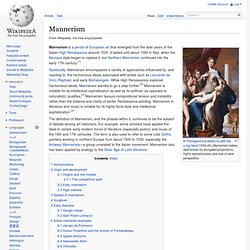
It lasted until about 1580 in Italy, when the Baroque style began to replace it, but Northern Mannerism continued into the early 17th century.[1] Stylistically, Mannerism encompasses a variety of approaches influenced by, and reacting to, the harmonious ideals associated with artists such as Leonardo da Vinci, Raphael, and early Michelangelo. While High Renaissance explored harmonious ideals, Mannerism wanted to go a step further.[2] Mannerism is notable for its intellectual sophistication as well as its artificial (as opposed to naturalistic) qualities.[3] Mannerism favours compositional tension and instability rather than the balance and clarity of earlier Renaissance painting. Mannerism in literature and music is notable for its highly florid style and intellectual sophistication.[4] Nomenclature[edit]
Neoclasicismo hispanoamericano. Art cyclopedia: The Fine Art Search Engine. Historia del Arte. Untitled. Classical order. Elements[edit] Measurement[edit] Greek orders with full height.
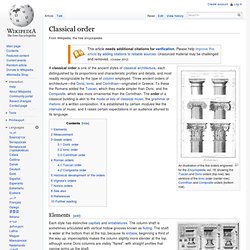
Renaissance. The Renaissance (UK /rɨˈneɪsəns/, US /ˈrɛnɨsɑːns/, French pronunciation: [ʁənɛsɑ̃s], from French: Renaissance "re-birth", Italian: Rinascimento, from rinascere "to be reborn")[1] was a cultural movement that spanned the period roughly from the 14th to the 17th century, beginning in Italy in the Late Middle Ages and later spreading to the rest of Europe.

Though availability of paper and the invention of metal movable type sped the dissemination of ideas from the later 15th century, the changes of the Renaissance were not uniformly experienced across Europe. In politics, the Renaissance contributed the development of the conventions of diplomacy, and in science an increased reliance on observation. Historians often argue this intellectual transformation was a bridge between the Middle Ages and Modern history.
Parmigianino. Girolamo Francesco Maria Mazzola (also known as Francesco Mazzola or, more commonly, as Parmigianino ("the little one from Parma"); 11 January 1503 – 24 August 1540) was an Italian Mannerist painter and printmaker active in Florence, Rome, Bologna, and his native city of Parma.
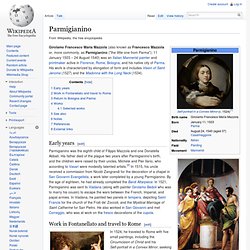
His work is characterized by elongation of form and includes Vision of Saint Jerome (1527) and the Madonna with the Long Neck (1534). Early years[edit] Work in Fontanellato and travel to Rome[edit] Renaissance of the 12th century. The Renaissance of the 12th century was a period of the many changes at the outset of the High Middle Ages.
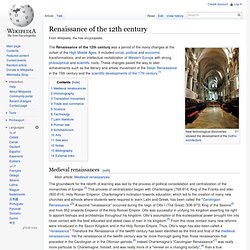
It included social, political and economic transformations, and an intellectual revitalization of Western Europe with strong philosophical and scientific roots. These changes paved the way to later achievements such as the literary and artistic movement of the Italian Renaissance in the 15th century and the scientific developments of the 17th century.[1] Parmigianino 2003. Untitled Document.